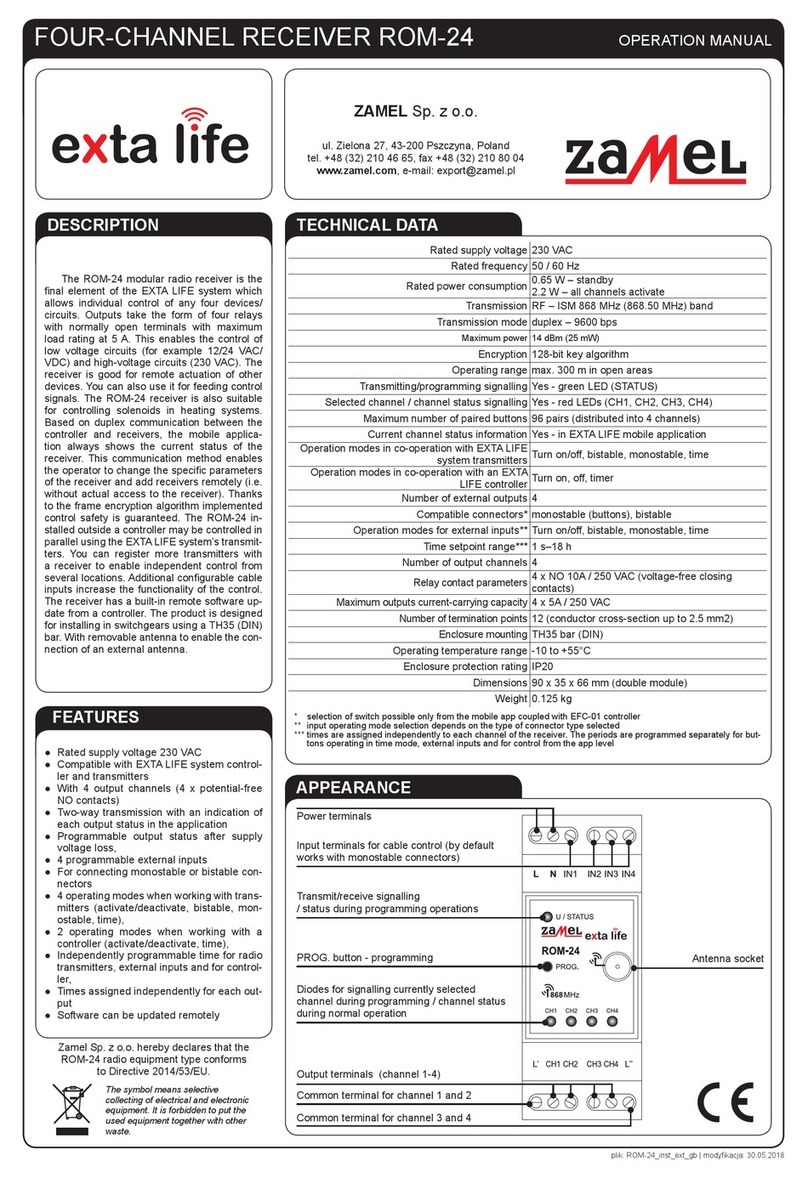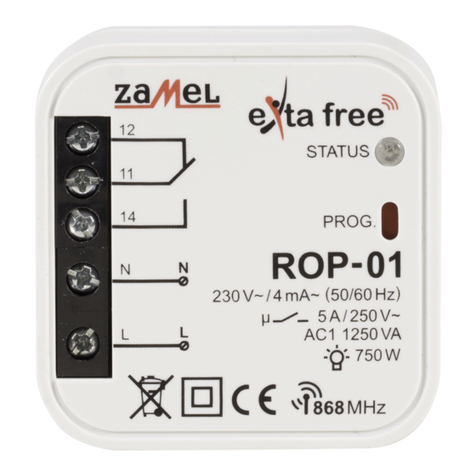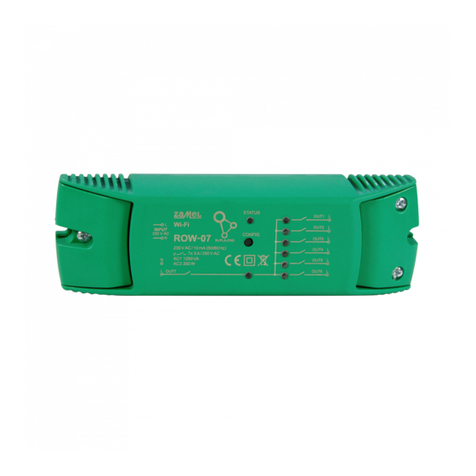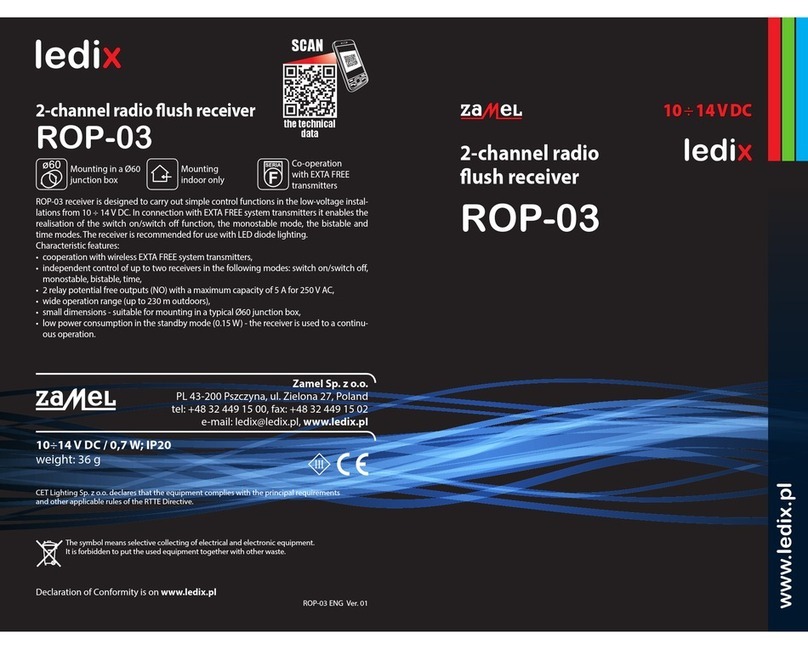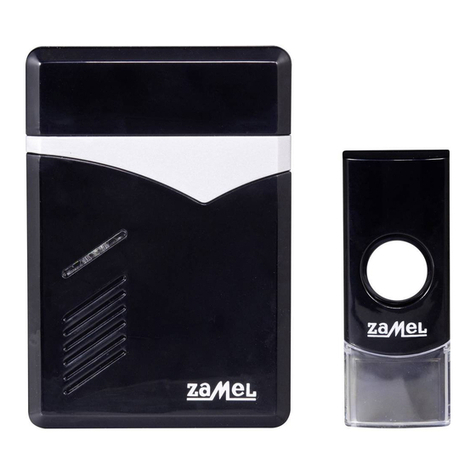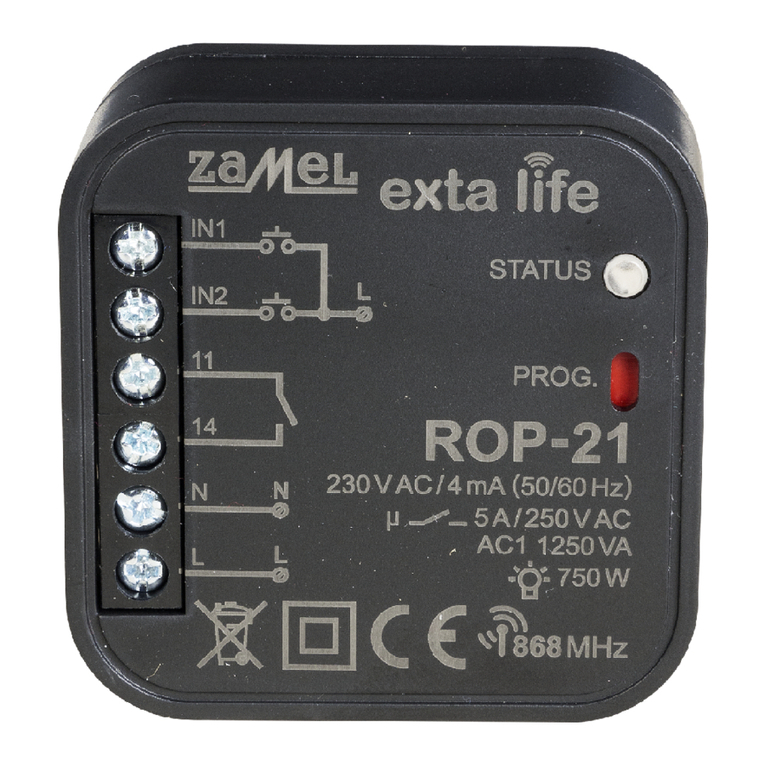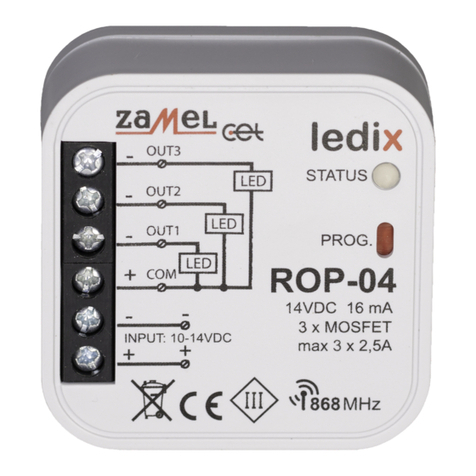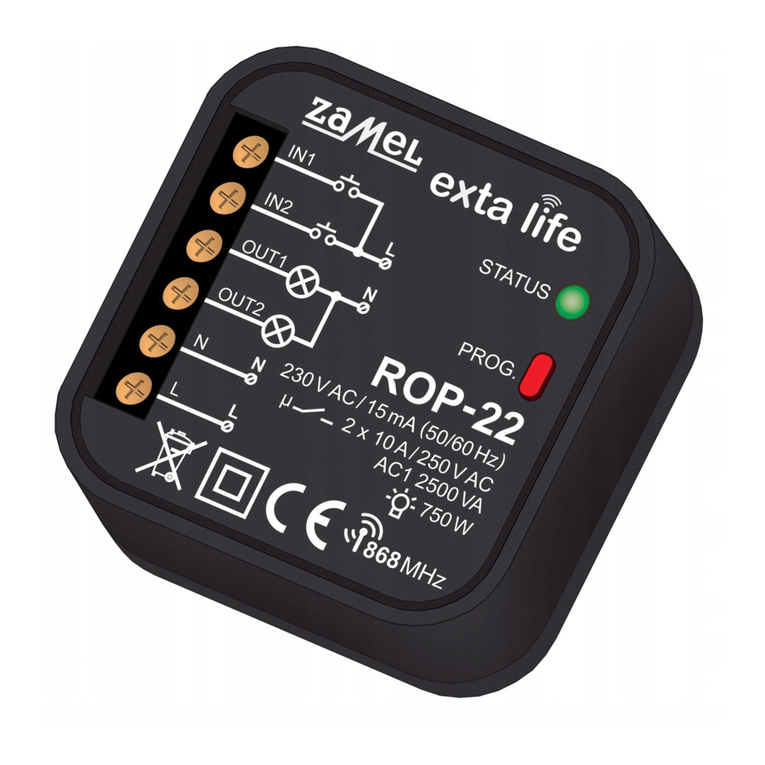
DIRECT PROGRAMMING USING PROG BUTTON
You can use the PROG button on the receiver to directly assign radio transmitters to the receiver.
PROGRAMMING BUTTONS TO CHANNEL ONE (CH1) Using 2-button remote P-457/2 as an example
ON/OFF MODE
1. Briey press (1 s) the PROG button on the receiver; “CH1” LED lights up.
2. Wait approx. 2 s until STATUS LED lights up. After the STATUS LED is lit, within 5 s briey press the button which is assigned to activate function (for
example „1”).
3. STATUS LED will go off and light up again.
4. Within the next 5 s briey press the button assigned to the “deactivate” function (e.g. “2”).
5. After correctly pressing the buttons, several quick blinks of STATUS LED occur and “CH1” LED turns off.
BISTABLE MODE
1. Briey press (1 s) the PROG button on the receiver; “CH1” LED lights up.
2. Wait approx. 2 s until STATUS LED lights up. After the STATUS LED is lit, within 5 s briey press and hold the button which you want to assign in bistable
mode (for example „1”).
3. STATUS LED will go off and light up again.
4. Within next 5 s, release the button to be assigned to the bistable mode (e.g. “1”).
5. After correctly pressing the button, several quick blinks of STATUS LED occur and “CH1” LED turns off.
MONOSTABLE MODE
1. Press the button you want to enter in monostable mode (for example „1”).
2. While holding the transmitter button pressed, briey press (1 s) the PROG button on the receiver; “CH1” LED lights up.
3. Wait approx. 2 s until STATUS LED lights up. After the STATUS LED is lit, within 5 s release the transmitter button you want to enter in monostable mode.
4. STATUS LED will go off and light up again.
5. Within next 5 s briey press the button to be entered in the monostable mode again.
6. After correctly pressing the button, several quick blinks of STATUS LED occur and “CH1” LED turns off.
TIME MODE
Step_1: Pairing a selected button with receiver
1. Briey press (1 s) the PROG button on the receiver; “CH1” LED lights up.
2. Wait approx. 2 s until STATUS LED lights up. After the STATUS LED is lit, within 5 s briey press and hold the button to be entered in the time mode (for
example „1”).
3. STATUS LED will go off and light up again.
4. Within next 5 s again briey press the button you selected before, the one to be entered in the time mode (for example „1”).
5. After correctly pressing the button, several quick blinks of STATUS LED occur and “CH1” LED turns off.
After pairing the selected button on the transmitter with the channel on the ROM-22 receiver, the period assigned to this button takes the default value of
10 s (default global time). To change the time, carry out the time programming procedure (Step_2). With the ROM-22 receiver, you can assign an individual
time to each button paired with channel 1 (CH1). The time is programmable from 1 s to 18 h.
Step_2: Programming the time assigned to the selected button in time mode (for channel 1)
1. Briey press (1 s) the PROG button on the receiver; “CH1” LED lights up.
2. Wait approx. 2 s until STATUS LED lights up. After the STATUS diode lights up, wait approx. 5 s until the STATUS diode goes off.
3. After the LED goes off in less than 5 s, briey press the transmitter button assigned to the channel 1 in time mode. (This refers to the transmitter you
want to program time).
4. The STATUS LED will start blinking which signals time measurement.
5. After a period of time you want to assign to the specic button has passed, briey press the button on the transmitter again.
6. The time programming procedure is now complete which will be conrmed by blinking STATUS LED and the „CH1” diode going off.
The time assigned to a button can only be changed through its reprogramming.
PROGRAMMING BUTTONS TO CHANNEL TWO (CH2) Using 2-button remote P-457/2 as an example
ON/OFF MODE
1. Briey press (1 s) the PROG button on the receiver; “CH1” LED lights up.
2. Briey press (1 s) the PROG button on the receiver again; “CH2” LED lights up and “CH1” LED will turn off.
3. Wait approx. 2 s until STATUS LED lights up. After the STATUS LED is lit, within 5 s briey press the button which is assigned to activate function (for
example „1”).
4. STATUS LED will go off and light up again.
5. Within next 5 s briey press the button assigned with the “deactivate” function (e.g. “2”).
6. After correctly pressing the buttons, several quick blinks of STATUS LED occur and “CH2” LED turns off.
BISTABLE MODE
1. Briey press (1 s) the PROG button on the receiver; “CH1” LED lights up.
2. Briey press (1 s) the PROG button on the receiver again; “CH2” LED lights up and “CH1” LED will turn off.
3. Wait approx. 2 s until STATUS LED lights up. After the STATUS LED is lit, within 5 s briey press and hold the button which you want to assign to bistable
mode (for example „1”).
4. STATUS LED will go off and light up again.
5. Within next 5 s, release the button to be assigned to the bistable mode (e.g. “1”).
6. After correctly pressing the button, several quick blinks of STATUS LED occur and “CH2” LED turns off.
MONOSTABLE MODE
1. Press the button you want to enter in monostable mode (for example „1”).
2. While holding the transmitter button pressed, briey press (1 s) the PROG button on the receiver; “CH1” LED lights up.
3. Briey press (1 s) the PROG button on the receiver again; “CH2” LED lights up and “CH1” LED will turn off.
4. Wait approx. 2 s until STATUS LED lights up. After the STATUS LED is lit, within 5 s release the transmitter button you want to enter in monostable mode.
5. STATUS LED will go off and light up again.
6. Within next 5 s briey press the button again to be entered in the monostable mode.
7. After correctly pressing the button, several quick blinks of STATUS LED occur and “CH2” LED turns off.
TIME MODE
Step_1: Pairing a selected button with receiver
1. Briey press (1 s) the PROG button on the receiver; “CH1” LED lights up.
2. Briey press (1 s) the PROG button on the receiver again; “CH2” LED lights up and “CH1” LED will turn off.
3. Wait approx. 2 s until STATUS LED lights up. After the STATUS LED is lit, within 5 s briey press and hold the button to be entered in the time mode (for
example „1”).
4. STATUS LED will go off and light up again.
5. Within next 5 s briey press the button to be entered in the time mode (for example „1”) again.
6. After correctly pressing the button, several quick blinks of STATUS LED occur and “CH2” LED turns off.
After successful assignment of the selected button on the transmitter to the channel 2 on the ROM-22 receiver in time mode, the period assigned to this but-
ton takes the default value of 10 s (default global time). To change the time, carry out the time programming procedure (Step_2). With the ROM-22 receiver,
you can assign an individual time to each button paired with channel 2 (CH2). The time is programmable from 1 s to 18 h.
OPERATING CONSIDERATIONS
OPERATING MODES
RECEIVER FUNCTIONALITY ROM-22:
1. The ROM-22 receiver may at the same time be controlled using:
- EXTA LIFE system transmitters (on/off, bistable, monostable, time mode),
- EXTA LIFE mobile app after pairing with controller (on/off, time mode),
- IN1, IN2 external inputs (operating mode depends on the connector type — see Input functionalities).
2. Current status of the specic receiver’s channel is signalled with LEDs CH1/CH2 and on the mobile app.
3. More EXTA LIFE buttons/receivers can be assigned to a single receiver — up to 96 pairs distributed in the receiver (e.g. 48 receivers in on/off mode).
4. Radio transmitters can be programmed with a receiver locally using the PROG button and remotely without access to the receiver using the mobile app.
5. Several receivers (channels) may work with a single transmitter; in such a situation it is recommended to assign a transmitter to each receiver (channel)
working in on/off mode.
6. A receiver may be paired with only one EXTA LIFE controller at a time.
7. Transmitter buttons assigned to the specic receiver’s channel may be deleted individually.
8. It is also possible to delete all buttons stored in the receiver’s memory at the same time by performing factory reset.
9. basic parameters of a ROM-22 receiver are congured from app level.
10. The parameters are congurable independently for channel 1 (CH1) and channel 2 (CH2).
11. You can use mobile app to execute remote software update in the receiver.
Default settings (factory settings) for a ROM-22 receiver
Parameter Default settings Conguration range
Output status after supply voltage loss Disabled (terminals 11-12 and 21-22) Yes – mobile app
Type of connectors compatible with inputs IN1,IN2 Monostable connectors (buttons) Yes – mobile app
Operating mode inputs IN1, IN2 bistable (cyclic change of output condition) Yes – mobile app
Default time for channel 1 (CH1) and channel 2 (CH2)* 10 s Yes – mobile app / PROG button
*Applies to receiver’s buttons assigned to specic outputs in time mode.
ON/OFF MODE
In the on/off mode, two transmitter buttons are always used for controlling the receiver’s channel. One of the buttons is always used for “on” function and the other
for the “off” function.
CAUTION! This mode is recommended for use to control more channels, i.e. more receivers using one transmitter.
BISTABLE MODE
In the bistable mode, only one transmitter button is used for controlling the receiver’s channel. That means that one button performs both the “on” and “off” func-
tion. Output control is executed as a cyclic change of status at subsequent presses of button on the transmitter. The bistable mode enables independent control of
more receivers using a single transmitter. For example when using remote a 4-channel remote control P-457/4, it is possible to independently congure 4 circuits
(channels).
CAUTION! The bistable mode is not recommended for simultaneous control over than one receiver (channel).
MONOSTABLE MODE
In the monostable mode, only one transmitter button is used for controlling the receiver’s channel. The receiver’s output is active as long as the transmitter key
is pressed.
TIME MODE
In the time mode, only one transmitter button is used for controlling the specic transmitter’s channel. The receiver’s output is activated by pressing the transmitter
button and it deactivates automatically after a preset time. Pressing the transmitter button during the countdown time results in quicker deactivation of the receiv-
er’s output (system without retriggering of time). Activation time can be programmed in the range from 1 s to 18 h. With ROM-22 receiver you can set independent
times for each button assigned in the time mode, for each local input and for control from application.
ACTIVATE MODE
This mode is available only from installation connectors connected to inputs IN1/IN2. In this mode you can only activate the specic channel, i.e. output in a
receiver.
DEACTIVATE MODE
This mode is available only from installation connectors connected to inputs IN1/IN2. In this mode it is possible to deactivate the specic channel (output) in a
receiver.
ROM-22 receiver’s operating modes summary
Operating mode Radio transmitters EXTA LIFE Application EXTA LIFE Monostable connector (button) Bistable connector
on/off mode + + (default) - -
bistable mode + - + (default) -
monostable mode + - + +
time mode + + + +
activate mode - - + +
deactivate mode - - + +
inactive - - + +
With EXTA LIFE radio transmitters, the operating mode is set by assigning the correct transmitter buttons to the receiver. In other cases, operating mode is con-
gured using the EXTA LIFE mobile app.
